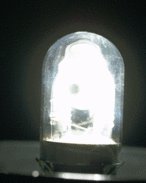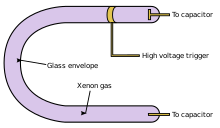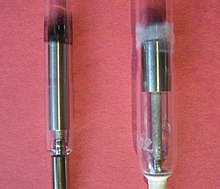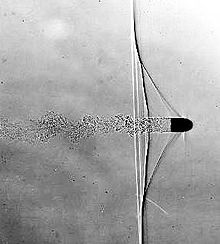Flashtube
A charged capacitor is usually used to supply energy for the flash, so as to allow very speedy delivery of very high electrical current when the lamp is triggered.In some applications, the emission of ultraviolet light is undesired, whether due to production of ozone, damage to laser rods, degradation of plastics, or other detrimental effects.Thicker materials can generally handle more impact energy from the shock wave that a short-pulsed arc can generate, so quartz as much as 1 mm thick is often used in the construction of flashtubes.Flashtubes usually have a cathode with a flattened radius, to reduce the incidence of hot spots and decrease sputter caused by peak currents, which may be in excess of 1000 amperes.The capacitance of the glass couples the trigger pulse into the envelope, where it exceeds the breakdown voltage of the gas surrounding one or both of the electrodes, forming spark streamers.Therefore, because the trigger-transformer has very low impedance, the transformer, triggering-circuit, and silicon controlled rectifier (SCR) must be able to handle very high peak-currents, often in excess of 1500 amps.This type of triggering is used mainly in very fast rise time systems, typically those that discharge in the microsecond regime, such as used in high-speed, stop-motion photography or dye lasers.The prepulse heats the gas, producing a dim, short-lived afterglow that results from free electrons and ionized particles that remain after the pulse shuts down.Ablative flashtubes are typically constructed using quartz tubing and one or both electrodes hollowed out, allowing a vacuum pump to be attached to control the gas pressure.When the gas reaches a low enough pressure (often just a few torr) randomly-ionized particles are able to accelerate to velocities sufficient to begin ejecting electrons from the cathode as they impact its surface, resulting in a Townsend avalanche that causes the lamp to self-flash.However, because of the low pressure, the particles have room to accelerate to very high speeds, and the magnetic forces expand the arc so that the bulk of its plasma becomes concentrated at the surface, bombarding the glass.[7][8] In addition, an insulated-gate bipolar transistor (IGBT) can be connected in series with both the trigger transformer and the lamp, making adjustable flash durations possible.The resistance in flashtubes varies greatly, depending on pressure, shape, dead volume, current density, time, and flash duration, and therefore, is usually referred to as impedance.However, neon signs emit red light because of extremely low current-densities when compared to those seen in flashtubes, which favors spectral lines of longer wavelengths.Optimum output-efficiency in the visual range is obtained at a density that favors "greybody radiation" (an arc that produces mostly continuum emission, but is still mostly translucent to its own light; an effect similar to sunlight when it passes through a cloud).As current densities become even higher, visually, xenon's output spectrum will begin to settle on that of a blackbody radiator with a color temperature of 9800 kelvins (a rather sky-blue shade of white).At very high current-densities, all gases will begin to operate as blackbody radiators, with spectral outputs resembling a blue giant star, centered in the UV.For extremely fast systems, low-inductance axial-leads, such as copper tubing, plastic-core wires, or even hollowed electrodes, may be used to decrease the total-system inductance.Compensating for this usually requires lowering the capacitance as pulse duration decreases, and then raising the voltage proportionately in order to maintain a high enough energy-level.Even if the amount of energy (joules) that is used remains constant, electrical power (wattage) will increase in inverse proportion to a decrease in discharge time.Extremely fast systems, with inductance below critical damping (0.8 microhenries), usually require a shunt diode across the capacitor, to prevent current reversal (ringing) from destroying the lamp.The limits to long pulse durations are the number of transferred electrons to the anode, sputter caused by ion bombardment at the cathode, and the temperature gradients of the glass.Flashtubes were mainly used for strobe lights in scientific studies, but eventually began to take the place of chemical and powder flashbulbs and flash lamps in mainstream photography.[25] Because electrical arcs could be made that were much faster than mechanical-shutter speeds, early high-speed photographs were taken with an open-air, electrical-arc discharge, called spark photography, helping to remove blur from moving objects.This was typically done with the shutter locked open while in a dark or dimly lit room, to avoid overexposing the film, and a method of timing the flash to the event to be photographed.[26] Open-air spark systems were fairly easy to build, but were bulky, very limited in light output, and produced loud noises comparable to that of a gunshot.Wanting to photograph the motion of a motor in vivid detail, without blur, Edgerton decided to improve the process of spark photography by using a mercury-arc rectifier, instead of an open-air discharge, to produce the light.Edgerton decided to try a noble gas instead, feeling that it would not be as temperature dependent as mercury, and, in 1930, he employed the General Electric company to construct some lamps using argon instead.In the 1969 book The Andromeda Strain and the 1971 motion picture, specialized exposure to a xenon flash apparatus was used to burn off the outer epithelial layers of human skin as an antiseptic measure to eliminate all possible bacterial access for persons working in an extreme, ultraclean environment.Frame 6: Fully heated, resistance and voltage stabilize into an arc and the full current load rushes through the tube, causing the xenon to emit a burst of light.

















flashlightflash-lampelectrostatic dischargeincoherenthermetically sealednoble gascapacitorelectrical currentfused quartzborosilicatecamera lensphotographyring flashestitanium dioxidesolarizationceriumfluorescencequartzdeionized waterelectrodesmolybdenumlaser pumpingtungstenmelting pointthermionic emissionCathodesbariumwork functionAnodeslanthanumarc lampssputterkilopascalsatmosphereshigh voltagestep up transformerrectifierresistanceionizedelectric currentplasmasmartphoneselectrostaticcapacitancevoltage droplasersinductorsilicon controlled rectifierthyristorspark gaprise timedye lasersablationconversion efficiencytitanium sapphirewaveformsvacuum pumpTownsend avalancheinsulated-gate bipolar transistorcurrent densityimpedanceresistivitynegative resistancecolor renderingspectral linesneon signscontinuumblack-body radiationcolor temperatureabsorption linesneodymiumblue giantHeliumKryptonNitrogenoxygenelectronspositively ionized atomsskin effecteddy currentsbremsstrahlungenergy densityinductanceannular cross sectionjouleswattagepulsed powercritical dampingcurrent reversaltemperature gradientscoolingmicrosecondmillisecondsCarbon nanotubesintense pulsed lightlesionsCatastrophic failureenergystructural failurearc flashsupersonicshock-wavepulsed-powertemperature gradientthermally expandingcathodejitterNational Ignition Facilityphotographicstrobe lightsvery high-speed or "stop-motion" photographyHarold Edgertonaircraft warning lightsemergency vehicle lightingfire alarm notification appliancesanticollision beaconsdentistrywavelengthsultravioletpumpingexcited statescoherentmonochromaticlasing mediuminertial confinement fusionDisinfection robots